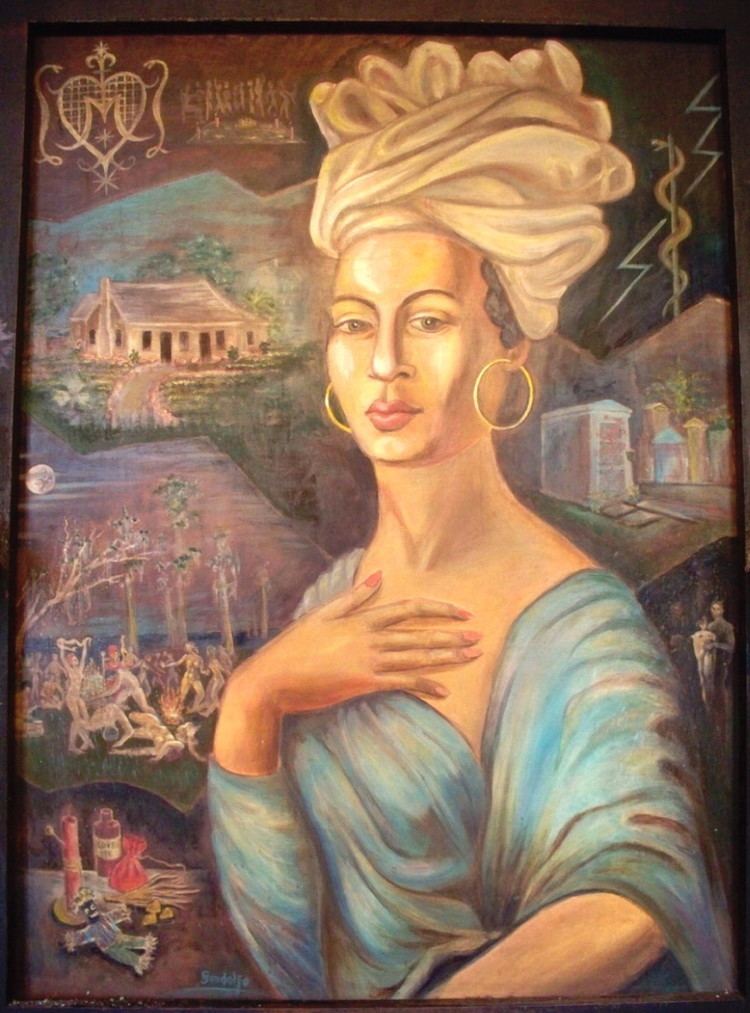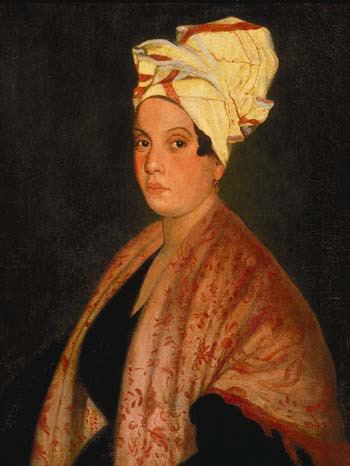Nationality American Spouse(s) Jacques Paris | Name Marie Laveau Books Black and White Magic | |
 | ||
Full Name Marie Catherine Laveau Religion Roman Catholic with Voodoo roots Children Felicite Paris, Marie Angelie Paris, Marie Philomene Glapion, Marie Laveau II Similar People Delphine LaLaurie, Angela Bassett, Axeman of New Orleans Died June 15, 1881 (aged 79), New Orleans, Louisiana, U.S. | ||
Marie Laveau: The New Orleans Voodoo Queen (Occult History Explained)
Marie Catherine Laveau (September 10, 1801– June 15, 1881) was a Louisiana Creole practitioner of Voodoo, who was renowned in New Orleans. Her daughter, Marie Laveau II, (1827 — c. 1862) also practiced rootwork, conjure, Native American and spiritualism as well as Louisiana or what is known today as New Orleans Voodoo. She and her mother had great influence over their multiracial following. "In 1874 as many as twelve thousand spectators, both black and white, swarmed to the shores of Lake Pontchartrain to catch a glimpse of Marie Laveau II performing her legendary rites on St. John's Eve (June 23–24)."
Contents
- Marie Laveau The New Orleans Voodoo Queen Occult History Explained
- Marie laveau love spell romance is just around the corner
- Early life
- Personal life
- Career
- Death
- Legacy
- Artistic legacy
- Biographies
- References

Marie laveau love spell romance is just around the corner
Early life

Historical records surmise that Marie Laveau was born free in the French Quarter of New Orleans, Louisiana, Thursday September 10, 1801. She was the biological daughter of Marguerite Henry (aka Marguerite D'Arcantel), a free woman of color who was of Native American, African and French descent, and Charles LaVeau, a free man of color, of African and French descent, and a merchant. On August 4, 1819, she married Jacques (or Santiago, in other records) Paris, a French immigrant who had fled as a refugee from the black Haitian massacre in the former French territory Saint-Dominque. Their marriage certificate is preserved in the St. Louis Cathedral in New Orleans. The wedding mass was performed by Father Antonio de Sedella, the Capuchin priest known as Pere Antoine.

The death of Jacques Paris was recorded in 1820. He was part of a large French immigration of refugees to New Orleans in 1809, after the Haitian Revolution of 1791-1804. They had two daughters, Felicite in 1817 and Angele in 1820. Both disappear from the records in 1820's.
Personal life

Little is known with certainty about the life of Marie Catherine Laveau. Marie Catherine (1801-1881) was approximately 1/3 each African, Native American and White. Laveau's only two children to survive into adulthood were daughters. The elder named Marie Euchariste Eloise Laveau (1827-1860-2) went on to become Queen known as Marie II. She had 5 children who bore the surname Crocker. All but one died in childhood or early adulthood. There were no further descendants from that line. The second daughter named Marie Philomene Glapion (1836-1897) became placée to Emile Alexandre Legendre (an insurance clerk). She had 6 children with him 2 of which died in infancy. Records show that direct descendants of Marie & Christophe through Philomene Legendre moved to St. Louis, Mississippi Gulf Coast and Kentucky.
She took a lover, Christophe Dominick Duminy de Glapion, (a white man of French descent) with whom she lived until his death in 1855. They were reported to have had 15 children (or, perhaps fifteen children and grandchildren), including Marie Laveau II, born c. 1827, who sometimes used the surname "Paris" after her mother's first husband. Records show they had 7 children born and baptized. Christophe Duminy de Glapion had a second cousin named Alexis Celestin Glapion born 1834, son of furniture maker Celestin Glapion. He stayed in New Orleans where he and his wife Emma Vicknaire had 11 children.
Career
While it is difficult to determine the histories of the two Maries in tradition, it is believed that the elder Marie was a dedicated practitioner of Voodoo. The younger displayed more theatrical rubrics by holding public events (including inviting attendees to St. John's Eve rituals on Bayou St. John). "Laveau was said to have traveled the streets like she owned them" said one New Orleans boy who attended an event at St.John's. It is not known which (if either) had done more to establish the voodoo queen reputation.
"The only evidence that exist(s) of any sort of occupation she had was (as) a liquor importer (in 1832) on Dauphine Street in the Faubourg Marigny (in New Orleans)."Folklore says at one time she also became a hairdresser, to high standing locals of New Orleans and gained profitable information from working in her clientèle's homes.
Marie I in the 1820s and 1830s worked as a matchmaker in the famed Placage Balls. She helped white men find consorts that would be taken care of and lived in the Creole Cottages of the French Quarter, Treme and Marigny neighborhoods. There they would live with often their mothers and children born of the relationship. It was in these balls that Marie met her second common law husband Christophe Glapion.
Of Laveau's magical career, there is little that can be substantiated, including whether she had a snake she named Zombi after an African god, whether the occult part of her magic mixed Roman Catholic saints with African spirits, or whether her divinations were supported by a network of informants she developed while working as a hairdresser in prominent white households and in a brothel she ran. She appeared to excel at obtaining inside information on her wealthy patrons by instilling fear in their servants whom she either paid or cured of mysterious ailments.
Death
On June 17, 1881, the New Orleans newspaper the Daily Picayune posted her obituary, which, according to Voodoo in New Orleans by Robert Tallant, announced that Marie Laveau had died peacefully in her home. However, oral tradition states that she was seen by some people in town after her supposed demise. As well, one of her daughters, also named Marie (many of the daughters had Marie within their names due to Catholic naming practices) possibly assumed her position, with her name, and carried on her magical practice, taking over as the queen soon before or after the first Marie's death.
According to official New Orleans vital records, Marie Catherine Laveau Paris Glapion died on June 15, 1881, aged 79. The different spellings of her surname may result from a casual approach to spelling, and her age at death from conflicting accounts of her birth date.
Legacy
Laveau's name and her history have been surrounded by legend and lore. In 1982, The New Jersey-based punk rock group The Misfits were arrested and accused of attempting to exhume Laveau from her grave after a local concert. The arrest took place in nearby Cemetery No. 2 and there are conflicting accounts of the incident.
Marie Laveau is generally believed to have been buried in plot 347, the Glapion family crypt in Saint Louis Cemetery No. 1, New Orleans. But this has been disputed by at least Robert Tallant, a journalist who used her as a character in historical novels. Tourists continue to visit and some draw "X" marks in accordance with a decades-old rumor that if people wanted Laveau to grant them a wish, they had to draw an "X" on the tomb, turn around three times, knock on the tomb, yell out their wish, and if it was granted, come back, circle their "X," and leave Laveau an offering.
The tomb in Saint Louis Cemetery No. 1 was vandalized by an unknown person on December 17, 2013, by being painted over with pink latex paint. The paint was removed because the structure is made of old plaster and the latex paint would seal in moisture that would destroy the plaster. Some historical preservation experts criticized the decision by the Archdiocese of New Orleans, who maintain the cemetery, for their decision to use pressure washing rather than paint stripper to remove it.
As of March 1, 2015, there is no longer public access to St. Louis Cemetery No. 1. Entry with a tour guide is required. because of continued vandalism and destruction of tombs. This change was made by the Archdiocese of New Orleans to protect the tombs of the Laveau family as well as those of the many other dead interred there.
Although some references to Marie Laveau in popular culture refer to her as a "witch", she is properly described as a 'Voodoo queen'.
Artistic legacy
Because of her prominence within the history of Voodoo in New Orleans, Laveau has inspired a number of artistic renditions.
In visual art, the African American artist Renee Stout often uses Laveau as a visual motif.
Numerous songs about Marie Laveau have been recorded, including "Marie La Veau" by Papa Celestin, "Marie Laveau" by Shel Silverstein, "The Witch Queen of New Orleans" (1971) by Redbone, "Dixie Drug Store" by Grant Lee Buffalo, "X Marks the Spot (Marie Laveau)" by Joe Sample, "Marie Laveau" by Dr. John, "Marie Laveau" (2013) by Tao Of Sound, "Marie Laveau" by Bobby Bare, "Voodoo Queen Marie" to the minstrel tune "Colored Aristocracy" by The Holy Modal Rounders, and "The Widow Paris" by The Get Up Kids. Most recently the Danish metal band Volbeat released an album with a song entitled "Marie Laveau" (Seal The Deal & Let's Boogie, 2016). Marie Laveau is mentioned in the song "I Will Play for Gumbo" (1999) by Jimmy Buffett. Two of Laveau's nephews, banjoist Raymond Glapion and bassist Alcide "Slow Drag" Pavageau, became prominent New Orleans jazz musicians.
Laveau has offered inspiration for a number of fictional characters as well.
She is the protagonist of such novels as Robert Tallant's The Voodoo Queen (1956), Francine Prose's eponymous Marie Laveau (1977), and Jewell Parker Rhodes' Voodoo Dreams: A Novel of Marie Laveau (1993). Laveau appears as a supporting character in the Night Huntress novels by Jeaniene Frost, as a powerful ghoul still living in New Orleans in the 21st century. She also appears as a background character in Barbara Hambly's Benjamin January mystery series, set in New Orleans. Marie Laveau appears in Neil Gaiman's novel American Gods, under her married name, Marie Paris. Marie Laveau's tomb is the site of a secret, fictional underground voodoo workshop in The Caster Chronicles novel Beautiful Chaos by Kami Garcia and Margaret Stohl. Laveau's grave site, in Saint Louis Cemetery No. 1, is the setting of a pivotal scene in Robert J. Randisi's short story, "Cold As The Gun", from Foreshadows: The Ghosts of Zero. The mother of Hazel Levesque, one of the characters from Rick Riordan's The Heroes of Olympus book series, was known as "Queen Marie," a famous fortune teller who lived in New Orleans. In Charlaine Harris' "True Blood" (Sookie Stackhouse novels) book series, the character Hadley is lured to her death at the site of Marie Laveau's tomb.
Most prominently in comics, a character named Marie Laveau, based loosely on the real Marie Laveau, appears in Marvel Comics. She first appeared in Dracula Lives #2 in 1973. She is depicted as a powerful sorceress and Voodoo priestess with great magical powers and knowledge of arcane lore, including the creation of a potion made from vampire's blood that keeps her eternally youthful and beautiful. Also, a character named Marie Laveau, based loosely on the real Marie Laveau, appears in the Italian comic book Zagor.
In TV, a heavily fictionalized Marie Laveau (portrayed by Angela Bassett) appears as a character in American Horror Story: Coven. She also appears in the Canadian television series Lost Girl in episode 11 of season 4.
Her tomb is featured prominently in the video game Gabriel Knight: Sins of the Fathers by Jane Jensen. The game also tells her backstory as part of the overall background and context for the tale told in the game.
She inspired a Total Nonstop Action Wrestling gimmick, "The Voodoo Queen" Roxxi Laveaux.
